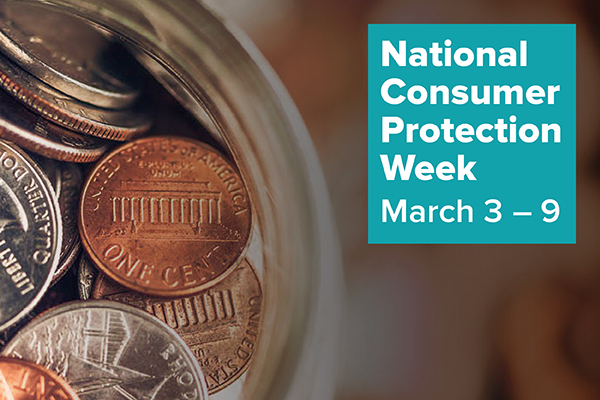March is here! Spring Break can’t be far away. This month we are focusing on protecting your rights as a consumer. We are all consumers at some point and we should take proactive steps to make sure we are making good financial decisions and setting ourselves up to be able to recover from identity theft.
This article is posted today so that you can read it before National Consumer Protection Week (March 3-9) begins. This week is dedicated to helping consumers know their rights and make well-informed decisions about their finances. Check out the FTC site linked above for more information
Identity theft has become a fact of life during the past decade. If you are reading this, it is a safe bet that your data has been breached in at least one incident. Does that mean we are all helpless? Thankfully, no. There is a lot we can do to protect ourselves from identity theft and to make recovery from cyber incidents quicker and less painful.
First, take control of your credit reports. Examine your own report at each of the “big three” bureaus. You get one free report from each credit bureau once per year. You can request them by going to AnnualCreditReport.com. Make sure there’s nothing inaccurate in those reports, and file for correction if needed. Then initiate a credit freeze at each of those plus two other smaller ones. Instructions can be found at Krebs on Security. To keep an eye on your credit report all year, space out your credit bureau requests by requesting a report from a different credit bureau every four months.
Next, practice good digital hygiene. Just as you lock your front door when you leave home and your car when you park it, make sure your digital world is secured. This means:
- Keep your operating system up to date. When OS updates are released, they fix errors in the code that could let the bad guys in. Be sure to update. It takes a few minutes, but could protect you from serious financial harm.
- Do the same for the application software you use. Web browsers, plug-ins, email clients, office software, antivirus/antimalware, and every other type of software has flaws. When those flaws are fixed, you are in a race to install that fix before someone uses the flaw against you. The vast majority of hacks leverage vulnerabilities that have a fix already available.
- Engage your brain. Think before you click. Think before you disclose personal information in a web form or over the phone.
- Think before you share on social media sites. Some of those fun-to-share-with-your-friends quizzes and games ask questions that have a disturbing similarity to “security questions” that can be used to recover your account. Do you want the answers to your security questions to be published to the world?
- Use a password manager and keep a strong, unique password for every site or service you use. That way a breach on one site won’t open you up to fraud at other sites. See the article posted right here on this website about password managers
- Back. It. Up. What do you do if you are hit with a ransomware attack? (Or a disk failure?) If you have a recent off-line backup, your data are safe, and you can recover without even thinking about paying a ransom. Check into cloud storage like Dropbox and OneDrive and backup options like iDrive, Acronis, and Carbonite.
- Full disk encryption is your friend. If your device is stolen, it will be a lot harder for a thief to access your data, which means you can sleep at night. This is available in both Windows and MacOS operating systems and almost all smartphones.
- Check all your accounts statements regularly. Paperless statements are convenient in the digital age. But it is easy to forget to check infrequently used accounts. Make a recurring calendar reminder to check every account for activity that you don’t recognize.
- Manage those old-style paper statements. Don’t just throw them in the trash or the recycle bin. Shred them with a cross-cut shredder. Or burn them. Or do both. Data stolen from a dumpster are just as useful as data stolen from a website.
If you’ve been a victim of identity theft:
- Create an Identity Theft Report by filing a complaint with the Federal Trade Commission online (or call 1-877-438-4338).
- Use the Identity Theft Report to file a police report. Make sure you keep a copy of the police report in a safe place.
- Flag your credit reports by contacting the fraud departments of any one of the three major credit bureaus: Equifax (800-685-1111); TransUnion (888-909-8872); or Experian (888-397-3742).
Set aside some time in March to manage your financial accounts and take precautions like those listed above.
For more information check out the FTC video “Five Ways to Help Protect Your Identity”
The content above is provided by the Awareness and Training Working Group of the EDUCAUSE Higher Education Information Security Council.
Be on the lookout for new security awareness posters in the residence halls and other locations on campus. There will be a table in Krannert toward the end of the month, after Spring Break. There will be two more chances to win a prize, one related to the posters and another at the table in Krannert.
Below is a list of useful resources, including some mentioned above.
- For more tips and tools on dealing with identity theft, visit the FTC Identity Theft website.
- Go to IdentityTheft.gov to report and recover from identity theft; you can also browse the FTC’s complete list of possible recovery steps.
- Download the FTC’s comprehensive guide for victims: Identity Theft – A Recovery Plan.
- Learn about current scams and how to protect yourself by visiting Fraud.org.
- Visit StaySafeOnline.org to review the tip sheet for victims of cybercrime and an infographic aimed at helping users stay safe from cybercrime during tax time.
- Access free annual credit reports at https://www.annualcreditreport.com.
- How to Freeze Your Credit (for free!).
- Learn more about National Consumer Protection Week.

 March News from Information Security
March News from Information Security




